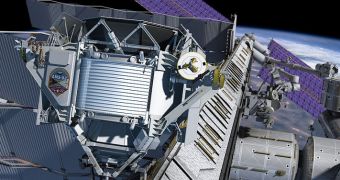Officials with the American space agency announce that they will load the space shuttle Endeavor's main payload onto the orbiter's cargo bay later this week. The complex maneuver should be among the last preparing the spacecraft for its final voyage.
At this point, Endeavor is scheduled to launch on STS-134, its final flight to the International Space Station (ISS), no earlier than April 18. However, it is currently still missing its primary payload, a $1.5-billion particle detector created to unlock the mysteries of the Universe.
The Alpha Magnetic Spectrometer (AMS) is arguably the most complex scientific experiment ever sent to space, NASA says. The component was encapsulated in a special canister at the Kennedy Space Center (KSC), in Florida.
Also in the canister are large space parts that the agency is sending to low-Earth orbit. As the shuttles are retired this year, the station will be left without any servicing spacecraft capable of delivering large spare parts in case of an emergency.
Therefore, it needs to stock up on everything that could go bust over the next couple of years. The 60-foot canister carrying the AMS and the space parts has been delivered to KSC Launch Pad 39A.
According to NASA, the payload will be placed inside the shuttle on Friday, March 26, about three weeks ahead of launch. The spacecraft will then need to undergo the remaining tests in its final flight configuration, SpaceRef reports.
The AMS was delivered from the CERN (European Organization for Nuclear Reasearch) Labs to NASA in anticipation of integration aboard the shuttle for its planned launch date. This experiment is critical important for a variety of reasons.
The most important is that it could finally help astrophysicists solve the issues of dark matter and antimatter, two concepts that need further clarification. These types of matter are also very elusive, which makes it very difficult for scientists to analyze them.
Then, the instrument could help investigators answer some relevant questions about the Universe as a whole, such as for example how come galaxies have enough mass to allow for the stars within to orbit at such high speeds.
Experts have known for a long time that something was off about this, and one of the roles of dark matter is to account for the so-called missing mass that experts cannot detect. The stuff is believed to interact with normal matter through gravitational pulls alone.
“We know the gas between galaxies in the Universe was ionized early in history, but the total light from these new galaxies may not be sufficient to achieve this.” explained University of Oxford expert Andrew Bunker.

 14 DAY TRIAL //
14 DAY TRIAL //